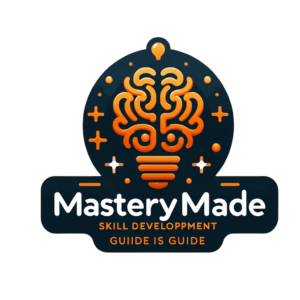At the heart of our pursuit for a more fulfilling life lies a simple truth: efficiency begets success. We’re passionate about introducing you to productivity hacks that promise to refine the way you tackle your daily tasks, enabling a significant elevation in both professional and personal realms. Our dedication to sharing efficiency tricks is fuelled by the belief that smart, time-saving techniques can profoundly transform your workflow.
Maintaining a healthy work-life balance is no longer a luxury—it’s a necessity. In the strategies we advocate, we prioritize balance, ensuring that our readers can achieve their goals without compromising the joys of personal life. Embrace our curated methods and anticipate a journey towards a more efficient, balanced, and productive you.
Key Takeaways
- Unlock the potential of productivity hacks for a more optimized lifestyle
- Discover efficiency tricks that save time and amplify output
- Implement work-life balance strategies for a well-rounded existence
- Learn to seamlessly integrate professional efficiency with personal contentment
- Transform your daily habits with actionable, effective productivity tips
Understanding the Importance of Efficient Workflows
We’ve all experienced the stress of a cluttered desk and a mounting to-do list overshadowing our workdays. But visualize a scenario where every task is aligned with clear goal setting methods, our time is maximized with expert time management tips, and the day’s work is defined by task prioritization strategies. This is the core of an efficient workflow—and the difference between feeling overwhelmed and feeling accomplished. As we uncover the facets of true productivity, let’s pull back the curtain on how an efficient workflow can be more than just a daydream.
What Constitutes an Efficient Workflow?
The hallmark of efficiency isn’t measured by the number of tasks completed but by the seamless integration of processes that make achieving those tasks possible. An efficient workflow is a dance of sorts—a rhythm of actions where each move is purposeful and contributes to the overall performance. It’s the minimized distractions, the automated processes, and the strategic breakdown of complex projects into manageable steps. These elements combine to form a symphony of productivity that propels us towards our objectives with precision and focus.
The Psychology Behind Productivity and Efficiency
A vast portion of our struggle with productivity is psychological. Procrastination, fear of failure, and a fixed mindset can all barricade our path to efficiency. But when we tap into a growth mindset, we view challenges as opportunities to learn and adapt. It’s about creating a positive feedback loop in our brain—we set a task, we achieve it, we reward ourselves, and we set the next task. This series of positive reinforcements is key to building and maintaining momentum in our work and, ultimately, in our careers.
Assessing Your Current Productivity Levels
Before we can improve, we must know where we stand. It begins with an honest and thorough assessment of our current work habits. By leveraging specific productivity assessments, we confront not only our strengths but also our limitations. Such introspection can be tough, but it’s necessary to forge the path toward a more productive self. Armed with insight into our workday tendencies, we can pivot our strategies effectively, leveraging the power of time management, prioritization, and goal-oriented methodologies.
| Productivity Aspect | Current Level | Desired Outcome | Strategy |
|---|---|---|---|
| Daily Task Completion | Inconsistent | Consistent & Efficient | Implement Pomodoro Technique |
| Long-Term Goals Progress | Slow | On Track | Set SMART Goals |
| Time Spent on Distractions | High | Minimal | Structured Breaks |
| Work-Life Balance | Skewed | Harmonious | Clearly Define Work Hours |
Implement Time Management Tips for Maximized Productivity
We understand that for many of us, the clock seems to race ahead, especially when deadlines loom and the to-do list keeps growing. That’s why we’ve honed in on effective time management tips that will help you take control of your schedule and boost your productivity. Integrating these strategies with stress management techniques and habit formation tips not only helps you get more done in less time but also ensures you do it without overwhelming yourself.

One of the best ways to enhance time management is through the art of breaking down tasks into smaller, more manageable segments. This tactic, known as ‘chunking’, allows you to focus on completing one piece of the puzzle at a time, providing a sense of accomplishment and reducing stress. Another popular method is the Pomodoro Technique, a tool that advocates for work intervals, traditionally 25 minutes in length, followed by short breaks to keep the mind fresh and focused.
- Chunking Tasks: By dividing larger tasks into smaller chunks, you can tackle them more efficiently, reducing the feeling of being overwhelmed.
- The Pomodoro Technique: This famous time management method encourages working in short bursts with regular breaks, promoting sustained concentration and preventing burnout.
- Daily Planning: Spend a few minutes each morning or the evening before planning your day. Prioritize your tasks and set clear goals for what you wish to achieve. This simple habit formation tip sets the tone for a productive day ahead.
In our pursuit to deliver real results, we fold in stress management techniques that work in tandem with time management. Regularly scheduled breaks, mindfulness practices, and setting realistic goals contribute to an environment where stress does not claim victory over your day. Moreover, habit formation is crucial. Instilling routines like regular review sessions to assess your workflow and adjusting your strategies can significantly improve your productivity over time.
- Take regular breaks to avoid mental fatigue.
- Practice mindfulness or meditation to reset your focus.
- Review and adjust your strategies weekly to foster continuous improvement in managing your time.
By embracing these tips and weaving them into the fabric of your daily work life, you will notice a substantial change in how you handle tasks and manage your stress levels. Remember, productivity is not about doing more—it’s about doing what’s necessary effectively and efficiently. Let’s continue to break free from the shackles of time constraints and stride towards a more productive and stress-free way of working.
Effective Organization Techniques to Streamline Your Tasks
Embracing organization techniques is not just about keeping a tidy desk; it’s about engineering a personal environment that fosters efficiency and productivity. We understand the importance of employing these techniques both in the physical space and the digital realm to advance work-life balance strategies.
Declutter Your Workspace for Enhanced Focus
To ignite our journey to enhanced productivity, let’s start with the basics: decluttering. A clutter-free space equals a clutter-free mind, allowing us to channel our energy into what’s truly important. By removing unnecessary items and streamlining our workspaces, we unveil an environment where focus thrives.
Digital Tools for Better Task Management
In the digital age, we’re fortunate to have tools that can handle our myriad tasks. Leveraging these tools not only sharpens our efficiency tricks but also places a world of productivity at our fingertips. Digital calendars, task managers like Trello or Asana, and project tracking applications such as Jira are essential companions in our quest for an organized workflow.
How to Categorize and Prioritize Workloads
The secret sauce to organization efficiency is knowing how to categorize and prioritize tasks. Recognizing the difference between urgent and important tasks allows us to allocate our time where it’s most impactful. Here’s an illustrative framework to guide us through this process:
| Category | Description | Tools |
|---|---|---|
| Urgent Tasks | Tasks that demand immediate attention and typically come with short deadlines. | Countdown timers, time-tracking apps |
| Important Tasks | Tasks that contribute to long-term goals and objectives but are not time-sensitive. | Goal-setting applications, strategy mapping |
| Low-Priority Tasks | Tasks that need to be done but have minimal impact on daily productivity. | To-do list apps, note-taking software |
| Delegable Tasks | Tasks that can be assigned to others, freeing up your time for high-impact activities. | Communication platforms, collaborative tools |

As we blend these organization techniques into our daily routines, we’ll not only see a boost in our efficiency but also a profound improvement in our work-life balance strategies. So, let’s roll up our sleeves and transform our work habits for the better!
Adopt These Stress Management Techniques for Better Focus
In today’s fast-paced world, we understand how critical it is to maintain mental clarity and composure, especially under pressure. That’s why we’ve curated a selection of stress management techniques to bolster your productivity and sharpen your focus. By merging these practices with effective goal setting methods and productivity hacks, you’re setting up a fortress of calm around your working life.
Coping Strategies to Maintain Composure Under Pressure
When deadlines loom and responsibilities mount, it’s crucial to have coping strategies in place. These techniques not only help in diffusing stress but also in maintaining a sense of control over your environment. We recommend setting clear, attainable goals – this helps in breaking down overwhelming tasks into manageable segments, thus reducing anxiety and enhancing focus.
Incorporating Relaxation into Your Daily Routine
Implementing moments of relaxation throughout your day can significantly reset your stress levels. Consider short, meditative breaks or consistent breathing exercises; these simple acts of mindfulness can help recalibrate your mind and body, fostering a productive and serene workspace. Remember, a relaxed mind is a productive one.
The Role of Physical Exercise in Stress Reduction
Physical activity is a powerhouse when it comes to stress management. It not only invigorates your body but also clears your mind, releasing endorphins which act as natural stress relievers. A daily dose of exercise can sharpen your focus, elevate your mood, and improve overall productivity.
| Technique | Benefits | Application in Daily Routine |
|---|---|---|
| Goal Setting | Provides direction and benchmarks for success | Morning planning session |
| Mindfulness Meditation | Enhances focus, reduces anxiety | Short breaks throughout the day |
| Physical Exercise | Increases blood flow and mood | Activity breaks or post-work sessions |
Conclusion
In wrapping up our discussion on productivity hacks, we’ve explored a multitude of techniques poised to revolutionize the way you approach tasks and time. From astute time management tips that can reshape the contours of your day to task prioritization strategies that fine-tune your focus, our aim has been to furnish you with actionable insights to tackle your to-do list with vigor and efficiency.
Moreover, the enduring power of well-established habit formation tips cannot be overstated; these are the quiet architects of long-term change that cumulatively build to form a sturdy foundation for continuous productivity enhancement. It is our hope that the strategies we’ve shared not only elevate your immediate output but also seed the habits that encompass a life of balanced achievement and personal fulfillment.
We encourage you henceforth to apply these principles to your daily routines. Let the cultivation of efficient habits and the refinement of your personal workflow be the hallmarks of your journey towards peak performance. Start today, and you may soon discover the resounding impact these refinements have on your professional trajectory and overall quality of life.
FAQ
What are some productivity hacks to enhance work efficiency?
Boosting work efficiency can be achieved through various productivity hacks such as the Eisenhower Matrix for task prioritization, the Pomodoro Technique for time management, and strategic breaks to maintain energy levels. Using tools like automation software and cutting down on multitasking also contribute significantly to enhancing efficiency.
How can I maintain a work-life balance while being productive?
To maintain a work-life balance, it is key to set clear boundaries between professional and personal time. Planning and scheduling work activities during specific hours, making time for self-care, and being fully present during non-work time help in achieving this balance. Effective delegation and saying no to non-essential tasks are also critical strategies.
What constitutes an efficient workflow?
An efficient workflow involves well-defined processes that streamline tasks, minimize distractions, and eliminate unnecessary steps. It should promote focused work sessions, effective communication, and leverage the use of technology for automating repetitive tasks. An efficient workflow is outcome-focused and adaptable to changing circumstances.
What are the psychological factors that affect productivity and efficiency?
Psychological factors such as motivation, mindset, and emotional well-being play a crucial role in productivity and efficiency. A growth mindset, positive reinforcement, goal alignment, and understanding the value of the task at hand can increase motivation and output. Additionally, coping with stress and managing anxiety levels are essential for consistent productivity.
How can I assess my current productivity levels?
You can assess your productivity levels by setting clear goals and tracking your progress towards these goals. Use tools like time-tracking apps to measure how much time is spent on specific tasks, and self-reflect on your effectiveness at the end of each day. Regular reviews of completed tasks versus time spent can give insight into areas for improvement.
What time management tips can help maximize my productivity?
Time management tips that can significantly boost productivity include prioritizing tasks based on urgency and importance, using a calendar to schedule and block time for work sessions, setting deadlines, and batch processing similar tasks together. Avoiding procrastination by tackling the most challenging tasks first and minimizing interruptions is also helpful.
Can stress management techniques improve my focus and productivity?
Yes, stress management techniques such as deep breathing exercises, mindfulness meditation, and regular physical activity can greatly improve focus and productivity. By reducing stress levels, you are better able to concentrate on tasks at hand and make more rational, clear-headed decisions that lead to efficient work.
How can I effectively declutter my workspace to enhance focus?
Decluttering your workspace involves removing unnecessary items, organizing tools and documents for easy access, and ensuring a clean environment. Consider going digital to minimize paper clutter, use desk organizers, label items, and maintain a regular cleaning schedule. A decluttered space can lead to fewer distractions and a sharper focus on tasks.
Which digital tools are recommended for better task management?
For better task management, tools such as Todoist, Trello, Asana, or Monday.com can help organize tasks, set deadlines, and collaborate with team members. Project management software like these enables users to visualize workflows, prioritize tasks, and receive reminders for upcoming deadlines, ultimately enhancing productivity.
How do I categorize and prioritize my workloads for optimal productivity?
Categorizing and prioritizing workloads can be done by identifying task importance, deadlines, and impact on overall goals. Use methods like ABCDE prioritization, the MoSCoW method, or the time-sensitive Urgent/Important Matrix to decide on the order of tackling tasks. Focus on high-impact tasks that align closely with your goals first.











